How IoT Sensors Transmit Pest Data
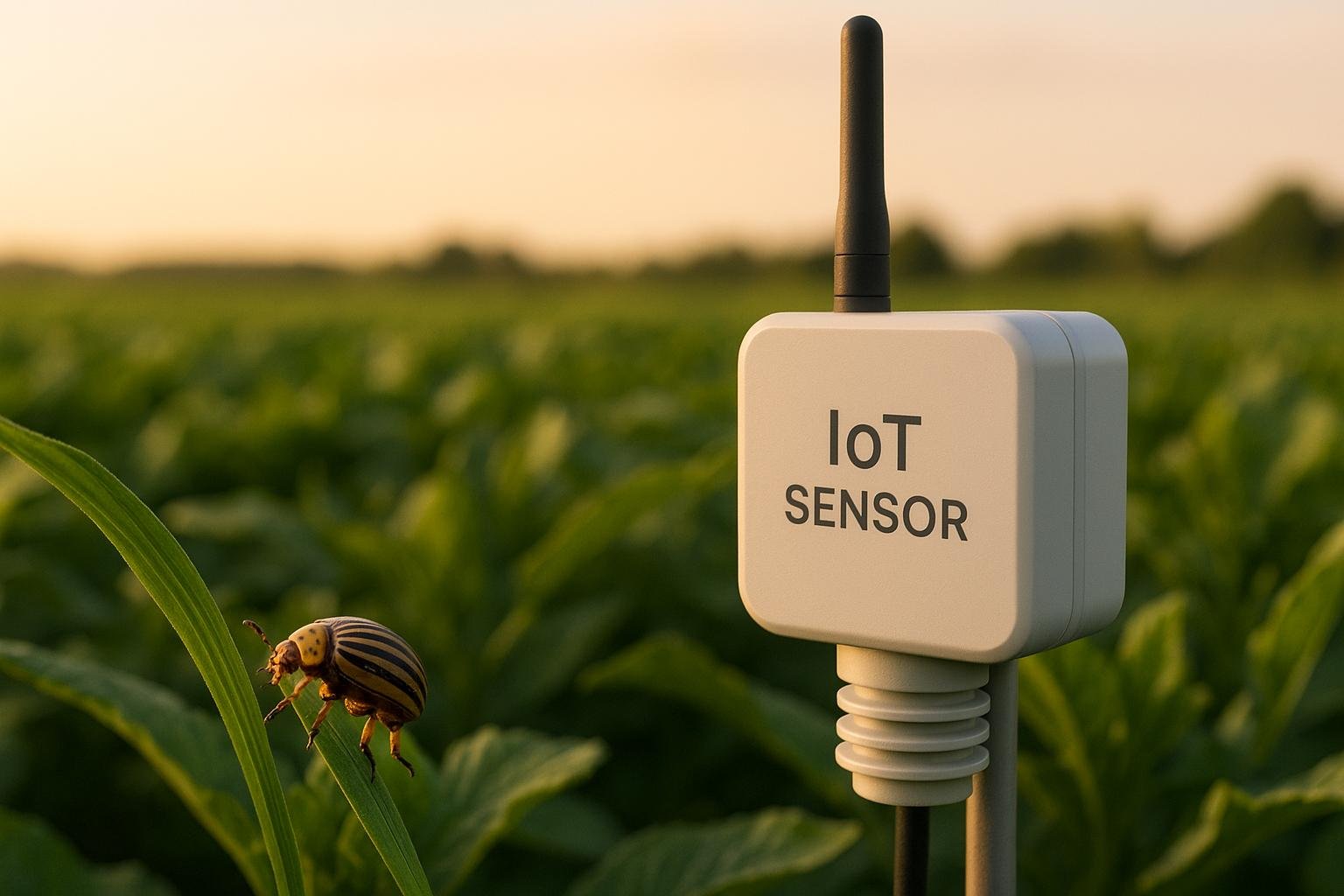
IoT pest sensors are changing how pests are monitored and managed. These devices use tools like cameras, infrared sensors, and acoustic detection to track pest activity in real time. They reduce the need for manual inspections and allow for faster, targeted responses. Here's how it works:
- Sensors: Detect pests using heat, sound, or image data and monitor environmental conditions like temperature and humidity.
- Wireless Data Transmission: Use protocols like ZigBee, Wi-Fi, or NB-IoT to send data to centralized systems for analysis.
- Gateways: Collect and process sensor data, ensuring efficient communication with cloud platforms.
- Cloud Integration: Analyzes data to identify pests, predict outbreaks, and provide actionable insights via dashboards or apps.
- Security: Encryption and authentication protect sensitive data during transmission.
These systems are helping farmers and gardeners reduce crop losses (20–40% globally) and lower pesticide use by offering precise, real-time pest control solutions. However, challenges like power limitations, signal range, and security risks require careful planning. By choosing the right sensors and protocols, IoT pest monitoring can improve efficiency and decision-making.
Main Parts of IoT Pest Monitoring Systems
Sensor Nodes
Sensor nodes are the backbone of IoT pest monitoring systems, gathering crucial data on pest activity and environmental conditions through various types of sensors [5].
For instance, image sensors capture high-quality photos and videos, which can be analyzed to identify specific pest species. Infrared sensors are particularly useful for detecting heat signatures from warm-blooded pests like rodents, even in complete darkness. Meanwhile, acoustic sensors can pick up subtle sounds, such as the scratching noises made by mice or the wing beats of insects.
In addition to these, environmental sensors track conditions like temperature, humidity, and light levels, which play a significant role in pest behavior and breeding cycles. Early detection of infestations often hinges on monitoring these environmental factors [5]. A notable example includes systems that use infrared sensors to send real-time alerts when pest activity is detected [2]. Some advanced setups even incorporate pheromone-based traps, which attract pests and assist in identification [6].
Research highlights the effectiveness of these sensor nodes, with detection accuracy reaching up to 96% and an F1-score of 84% [4]. Once collected, this data is sent to gateways for further processing and analysis.
Gateways and Data Collection
Once sensor nodes capture pest-related data, gateways step in to centralize and manage it. Acting as the system's communication hub, gateways connect sensor nodes to cloud-based platforms where deeper analysis takes place. These devices bridge the gap between the limited processing power of sensors and the advanced capabilities of cloud infrastructure [7].
"IoT Gateways are intelligent central hubs for Internet of Things (IoT) devices...they connect IoT devices that have limited compute and storage to the cloud where data is managed and is used by end-user applications." - Check Point Software [7]
Gateways simplify the process by aggregating data from multiple sensors, filtering unnecessary information, and pre-processing it before sending it to the cloud. This approach reduces bandwidth usage and minimizes latency [7][8].
Another key role of gateways is ensuring compatibility between devices from different manufacturers. By translating communication protocols, they allow sensors using various wireless standards to work together seamlessly [8]. Additionally, gateways act as a security layer, protecting sensitive agricultural data from potential cyber threats. In fact, some companies leveraging machine learning through IoT gateways have reported operational efficiency improvements of up to 25% [8].
Power Sources and Energy Management
Consistent power is critical for the uninterrupted operation of IoT pest monitoring systems. Since these systems often function in remote areas, reliable energy management becomes a top priority. Sensor nodes typically rely on batteries, which are optimized through low-power wireless protocols and energy-efficient designs to extend their lifespan [3].
Ensuring long-term, maintenance-free operation in challenging environments requires careful power planning. Without it, the effectiveness of pest monitoring systems could be compromised.
Wireless Communication Protocols for IoT Sensors
Common Wireless Protocols
Once the basics of wireless data transmission are clear, choosing the right protocol becomes a balancing act between range, speed, and power efficiency. Each protocol has its strengths, making it suitable for specific scenarios.
ZigBee is a go-to option for smaller setups like residential gardens. It creates mesh networks capable of supporting up to 65,000 devices, which is ideal for ensuring uninterrupted communication. If one sensor fails, others in the network step in to relay data, keeping the system running smoothly [10].
Wi-Fi, on the other hand, is perfect for applications requiring high-speed data transfer. For instance, systems that need to send large files, like high-resolution images from pest cameras, benefit from Wi-Fi's ability to achieve data rates exceeding 1 Gbit/s at close range [10]. Wi-Fi Direct, in particular, is significantly faster than Bluetooth. However, this speed comes with a trade-off: higher power consumption, meaning more frequent battery replacements or a need for constant power.
For larger agricultural areas, NB-IoT (Narrowband Internet of Things) excels. This low-power wide-area network (LPWAN) technology offers excellent long-distance coverage while keeping power use minimal [11].
LTE-M is another LPWAN option, offering a range of up to 3.1 miles (5 km) [11]. It’s particularly useful for mobile pest monitoring systems or setups requiring frequent data updates.
"LTE-M supports a very similar if not better coverage enhancement compared to other LPWA technologies."
- Gus Vos, Chief Engineer at Sierra Wireless [9].
Here’s a quick comparison of these protocols:
| Protocol | Range | Data Rate | Power Consumption | Best For |
|---|---|---|---|---|
| ZigBee | 33–330 feet | 250 kbps | Low | Small gardens, mesh networks |
| Wi-Fi | Local area | Over 1 Gbit/s | High | High-speed data, image transmission |
| NB-IoT | 0.62–6.2 miles | 250 kbps | Low | Large farms, long-range monitoring |
| LTE-M | Up to 3.1 miles | Up to 1 Mbps | Medium | Mobile systems, frequent updates |
How Data Moves Through the System
When a sensor detects pest activity, it processes the raw data - whether sound, image, or another signal - into a smaller, more manageable format. This reduces the amount of data to be transmitted, saving both bandwidth and battery power. From there, the data travels via the selected protocol, such as ZigBee, Wi-Fi, NB-IoT, or LTE-M, to the nearest gateway.
At the gateway, additional processing takes place. It consolidates data from multiple sensors, removes duplicates, and formats the information for transmission to the cloud. By handling these tasks locally, the gateway minimizes bandwidth usage and ensures only useful data is sent forward.
The final step involves transmitting this refined data to cloud servers or remote monitoring systems using internet connections like Wi-Fi, Ethernet, or cellular networks. In the cloud, the data is analyzed, alerts are generated if needed, and the results are presented on web dashboards or mobile apps. This streamlined process ensures accurate and actionable pest monitoring data throughout the system.
Keeping Data Transmission Secure
While efficiency is key, the security of transmitted data is equally important. Modern pest monitoring systems incorporate multiple layers of protection to safeguard information.
At the hardware level, sensors are designed to resist tampering and include secure boot features to block unauthorized access. Encryption keys are protected using hardware-based cryptography, making physical breaches far less effective [12].
Transmission and storage are secured using strong encryption algorithms like AES-256, ensuring intercepted data remains unreadable to unauthorized users [12]. Authentication measures, such as multi-factor authentication, unique device passwords, and role-based access control (RBAC), further restrict access to the system [12].
Regular updates are another critical component. Automatic firmware and software updates provide the latest security patches, while continuous system monitoring helps detect and neutralize threats before they escalate [12].
"Customers are responsible for encrypting data sent over the cellular network and securing devices, servers, and end-customer data. Connectivity providers secure their environments and the security of data routed between customer devices and its destination."
Additional network security measures, like private APNs, network segmentation, and intrusion detection systems, provide extra layers of defense. These tools monitor traffic for suspicious activity and can isolate compromised devices to prevent system-wide breaches [12].
Data Management and Cloud Integration
Data Processing and Storage
Once sensor data is transmitted to a gateway, the next step is processing it to extract meaningful insights. This data, often encoded using protocols like MQTT and compressed into binary formats, is optimized for faster transmission and reduced file size [13].
To ensure uninterrupted communication, repeaters or hubs boost signal strength and extend network coverage. For non-IP protocols like ZigBee, gateways play a crucial role by consolidating data from multiple sensors before sending it to the cloud [13].
In the cloud, the data undergoes several refinement processes, including data denoising (removing irrelevant noise), data imputation (filling in missing values), outlier detection, and data aggregation [15]. These steps ensure the data is accurate, complete, and ready for analysis.
Given the limited storage capacity of IoT devices, cloud storage becomes essential. It provides centralized, scalable, and redundant storage systems, making data easily accessible for retrieval and analysis [14].
Heartbeat Signals and Network Reliability
After data processing in the cloud, maintaining a stable and reliable connection is vital. This is particularly important for IoT systems monitoring pest activity, where even short network disruptions can compromise data collection and decision-making.
Analyzing and Displaying Pest Data
Once refined and stored, the data is transformed into actionable insights. Cloud platforms use advanced tools to analyze raw pest data, enabling AI systems to identify pests and suggest treatment strategies [16]. These systems combine real-time sensor readings with environmental data and historical pest trends to create detailed, data-driven recommendations.
Predictive models take this a step further by forecasting potential pest outbreaks based on factors like weather conditions and pest life cycles [16]. This allows gardeners and farmers to take preventive action before problems escalate. Additionally, smart monitoring systems provide constant surveillance and trigger alerts when pest activity exceeds normal levels [16].
Interactive dashboards and mobile apps enhance usability by displaying real-time data and sending notifications [17][18].
"We transform lengthy reports into interactive dashboards and key insights, to help you convert environmental data into decisions." - DiscoverEI [17]
The impact of these tools is evident. For instance, Semios collaborated with Google to improve almond production by using AI to reduce a moth population by 1.5 billion [16]. Similarly, FarmSense offers a field-based pest-monitoring platform that captures insect and environmental data, processes it with AI in the cloud, and provides precise recommendations [16].
AIGardenPlanner takes this integration further by combining IoT sensor outputs with AI-driven garden designs. It suggests pest-resistant plants and optimizes layouts based on local climate conditions, making gardening smarter and more efficient.
sbb-itb-4d6a8dd
🚀 Ready to Reinvent Your Garden?
Join thousands of homeowners who have transformed their gardens using our AI design tool. Upload one photo to explore endless possibilities.
Get your AI garden designs →Benefits and Challenges of Wireless Pest Data Transmission
Wireless Protocol Comparison
When it comes to pest monitoring systems, selecting the right wireless protocol depends on the size of your garden, its specific needs, and operational requirements. Each protocol has its strengths, and understanding their differences can help you make the best choice.
| Protocol | Range | Power Consumption | Data Rate | Network Size | Cost | Best For |
|---|---|---|---|---|---|---|
| ZigBee | 330 ft | Low | 250 kbps | 65,000 devices | Low | Small to medium setups with mesh networking |
| Wi-Fi | 330 ft | High | 150 Mbps | 32 devices | High | High-data applications with a steady power source |
| LoRa | 3.1 miles | Low | 50 kbps | 10,000 devices | Low | Large-scale, long-range monitoring needs |
ZigBee is a solid option for small to medium gardens, offering a balance of range, power efficiency, and scalability. Its mesh networking capability extends coverage and supports up to 65,000 devices, making it ideal for interconnected systems. LoRa, on the other hand, is perfect for large-scale, long-range monitoring, though it works better with smaller data packets. Wi-Fi offers the fastest data rates but comes with higher power consumption, making it suitable for sensors with a fixed power supply.
These unique characteristics of each protocol highlight the versatility of wireless systems in pest monitoring.
Advantages of Wireless Transmission
Wireless pest monitoring systems bring a host of benefits that can transform how you manage crops. One standout advantage is early detection of pest activity, which can reduce yield losses by an impressive 20–40% [20].
Cost savings are another big win. By eliminating the need for extensive wiring and cutting down on manual field inspections, wireless systems significantly reduce labor expenses [19]. Plus, their autonomous operation minimizes maintenance efforts while ensuring consistent performance [20].
Real-time monitoring is a game-changer, too. It allows farmers to remotely track crop health and apply pesticides only where needed, reducing chemical usage and its impact on the environment [1]. When paired with weather data, these systems can even predict pest outbreaks before they happen, giving you a proactive edge [1].
The adoption of wireless technologies in agriculture is growing at a rapid pace. By 2025, global IoT sensor installations in agriculture are expected to exceed 75 million units. Additionally, more than 80% of agricultural drones now use multispectral sensors to monitor crop health [21].
Limitations and Considerations
While wireless pest data transmission systems offer many advantages, they aren't without challenges. Security is a major concern, as wireless networks can be vulnerable to unauthorized access, eavesdropping, and denial-of-service attacks [24].
"Misconfigurations are the most common type of cloud security vulnerability." - U.S. National Security Agency (NSA) [25]
Power limitations also play a role, particularly in remote areas. Although protocols like ZigBee and LoRa are power-efficient, battery-operated sensors still require regular maintenance or alternative solutions like solar charging. Wireless power transfer technologies, while promising, face issues with efficiency, range, and environmental sensitivity [22].
Range is another factor to consider. A typical wireless access point covers 150–300 feet indoors and up to 1,000 feet outdoors [23]. Larger gardens may need multiple access points or a robust mesh network to ensure complete coverage.
Physical security risks, such as theft of unattended devices, also pose challenges [24]. Additionally, adverse weather conditions can disrupt signals, potentially leading to data gaps during critical monitoring periods.
Cost is another consideration. While wireless systems save on wiring and labor, larger deployments may require significant upfront investments in gateways, cloud storage, and data processing.
To address these challenges, consider implementing measures like strong passwords, encryption, and regular software updates. Intrusion detection systems and updated security software can further protect your devices [24]. Using VPNs for accessing data over public networks adds another layer of security [26]. Balancing these precautions with the benefits of wireless systems can help ensure a successful deployment.
Conclusion and Practical Applications
Key Takeaways
IoT pest sensors are reshaping the way we manage gardens, bringing real-time monitoring and automation into pest control. These systems not only streamline pest tracking but also use AI to predict outbreaks, reducing the need for manual inspections [2].
By applying treatments only where needed, IoT-enabled pest control systems significantly cut down on chemical pesticide use. This targeted approach helps protect beneficial insects and minimizes harmful chemical runoff. With the pest control market projected to hit $42.5 billion by 2032 [28], it's clear that demand for smarter solutions continues to grow.
These advancements are already proving their worth in real-world gardening and farming scenarios.
Real-World Garden Applications
Several companies are leading the charge in IoT pest monitoring. For instance, Rentokil's PestConnect uses infrared sensors to provide 24/7 monitoring, sending real-time alerts and offering analytics to pinpoint infestation sources [2] [28].
Another standout example is Blue River Technology, part of John Deere, which developed the See & Spray™ precision sprayer. This system uses computer vision to target weeds, helping farmers cut herbicide costs by up to 77% [28]. Similarly, Thinxtra employs IoT monitoring to detect rodents around the clock, reducing property damage and environmental impact [28].
In China's Shunyi district, an IoT-equipped strawberry greenhouse doubled its production and shaved nearly three weeks off its time to market [27]. These examples highlight how IoT systems, combined with cloud analytics, are driving smarter pest control. On a smaller scale, AI-powered image recognition tools integrated into mobile apps are making pest detection more accessible for smallholder farmers [30]. Meanwhile, smart traps equipped with cameras offer detailed insights into pest activity patterns [29].
How AIGardenPlanner Can Help
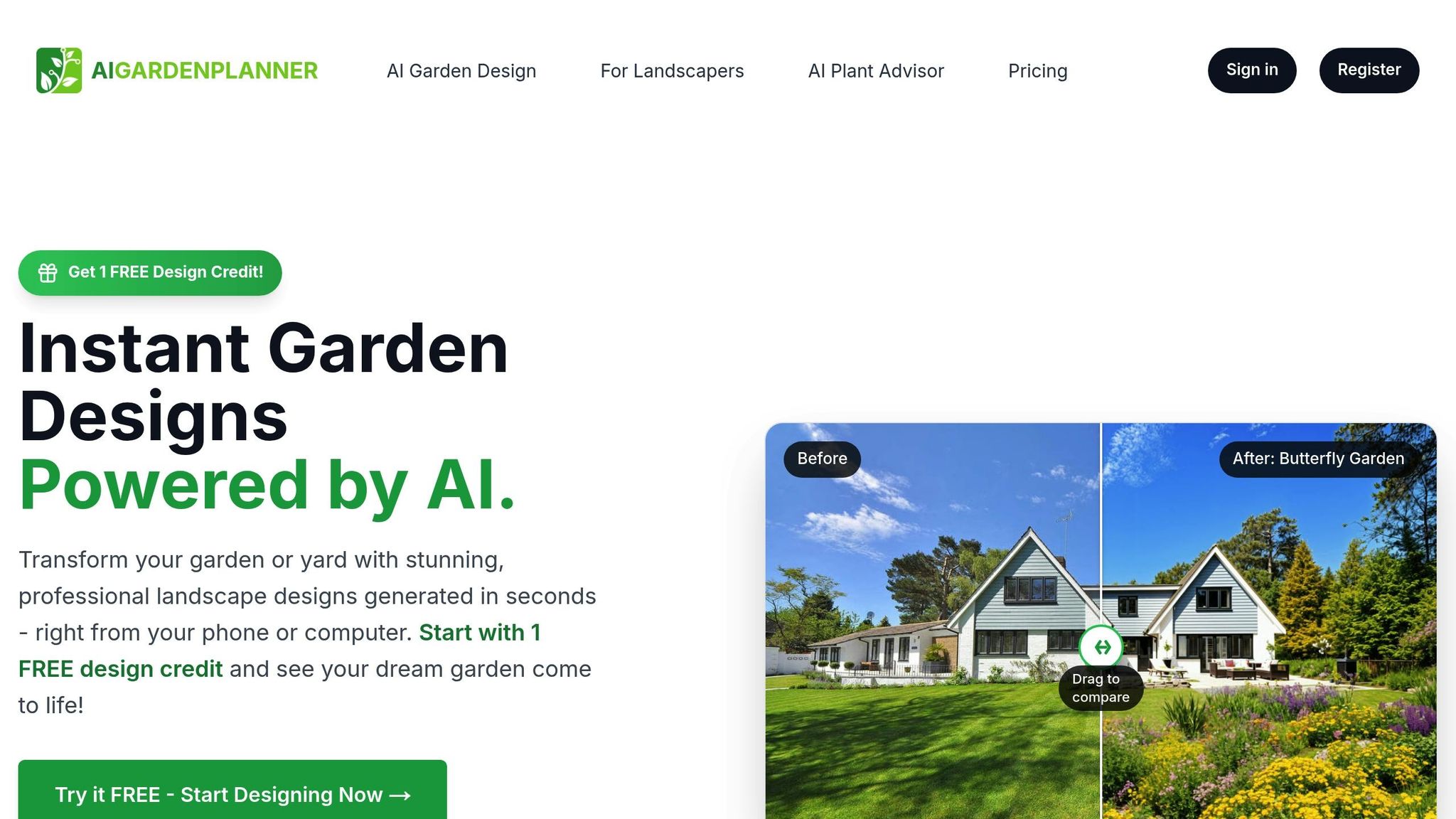
Building on the success of IoT sensors, AIGardenPlanner takes pest management to the next level by helping you design pest-resistant gardens. Its AI-powered tool creates layouts that naturally reduce pest problems through strategic plant placement and companion planting [31].
The platform provides tailored planting recommendations based on your local climate, soil type, and gardening preferences [31]. These suggestions include pest control tips that work seamlessly with IoT sensor data, creating a well-rounded approach to garden health.
With interactive features, AIGardenPlanner allows you to visualize how IoT pest sensors can fit into your garden layout. You can plan optimal sensor placement alongside plant positioning, ensuring your garden is both productive and protected. Detailed growing guides and maintenance schedules further help you align IoT monitoring with seasonal pest patterns and plant needs, giving you a smarter way to manage your garden.
PestTrap | Digital Pest Tracking Station | Monitor Pests Remotely

FAQs
How do IoT sensors make pest management more efficient than traditional methods?
IoT sensors are transforming pest management by offering early detection and real-time monitoring of pest activity. This means potential infestations can be spotted before they escalate, cutting down on the need for large-scale chemical treatments. The result? Less time, fewer resources, and a more efficient approach to pest control.
What’s more, these sensors allow for targeted interventions, meaning treatments are applied only where they’re truly needed. This reduces environmental impact, fine-tunes pest control efforts, and helps lower costs. In short, IoT technology is making pest management smarter, more precise, and easier to manage.
What challenges come with using IoT sensors for pest monitoring, and how can they be solved?
IoT sensors for pest monitoring come with their fair share of challenges. Some of the most common hurdles include connectivity problems, expensive equipment, ongoing maintenance requirements, data security concerns, and a shortage of technical know-how. These obstacles can limit the ability to fully harness the benefits of this technology.
However, there are ways to overcome these barriers. Improving network infrastructure or integrating edge computing can help resolve connectivity issues. Opting for cost-effective and scalable sensors can make the technology more accessible. To address security concerns, implementing robust data protection measures is key. Additionally, providing intuitive tools alongside practical training can help users navigate the technical aspects with ease. By addressing these challenges head-on, IoT sensors can become a more dependable and efficient tool for pest monitoring.
How does the choice of wireless protocol affect IoT pest monitoring systems?
The choice of wireless protocol in IoT pest monitoring systems is a key factor that directly affects their data reliability, range, power usage, and scalability. For instance, LoRaWAN and SigFox are excellent options for covering expansive areas like farms. These protocols are designed to offer long-range connectivity while keeping power consumption low, making them ideal for large-scale, energy-conscious monitoring setups.
In contrast, protocols such as Wi-Fi and ZigBee are better suited for smaller spaces where higher data transmission speeds are required, like greenhouses or urban gardens. However, these options typically demand more power and have a shorter range, which can influence battery life and system efficiency. The best protocol for a given application will depend on factors like the size of the monitored area, the availability of power sources, and the frequency of data transmission.
🎨 Visualize Your Dream Garden Today!
Transform any outdoor space into a professional landscape design in minutes. Just upload a photo, choose your style, and let our AI do the rest.
Start your garden transformation now →Related posts
Related Articles

Revolutionizing Garden Design: The Power of AI Tools
Explore the benefits and challenges of using free AI garden design tools to create personalized and sustainable garden layouts. Discover how AI technology is reshaping the landscaping industry.
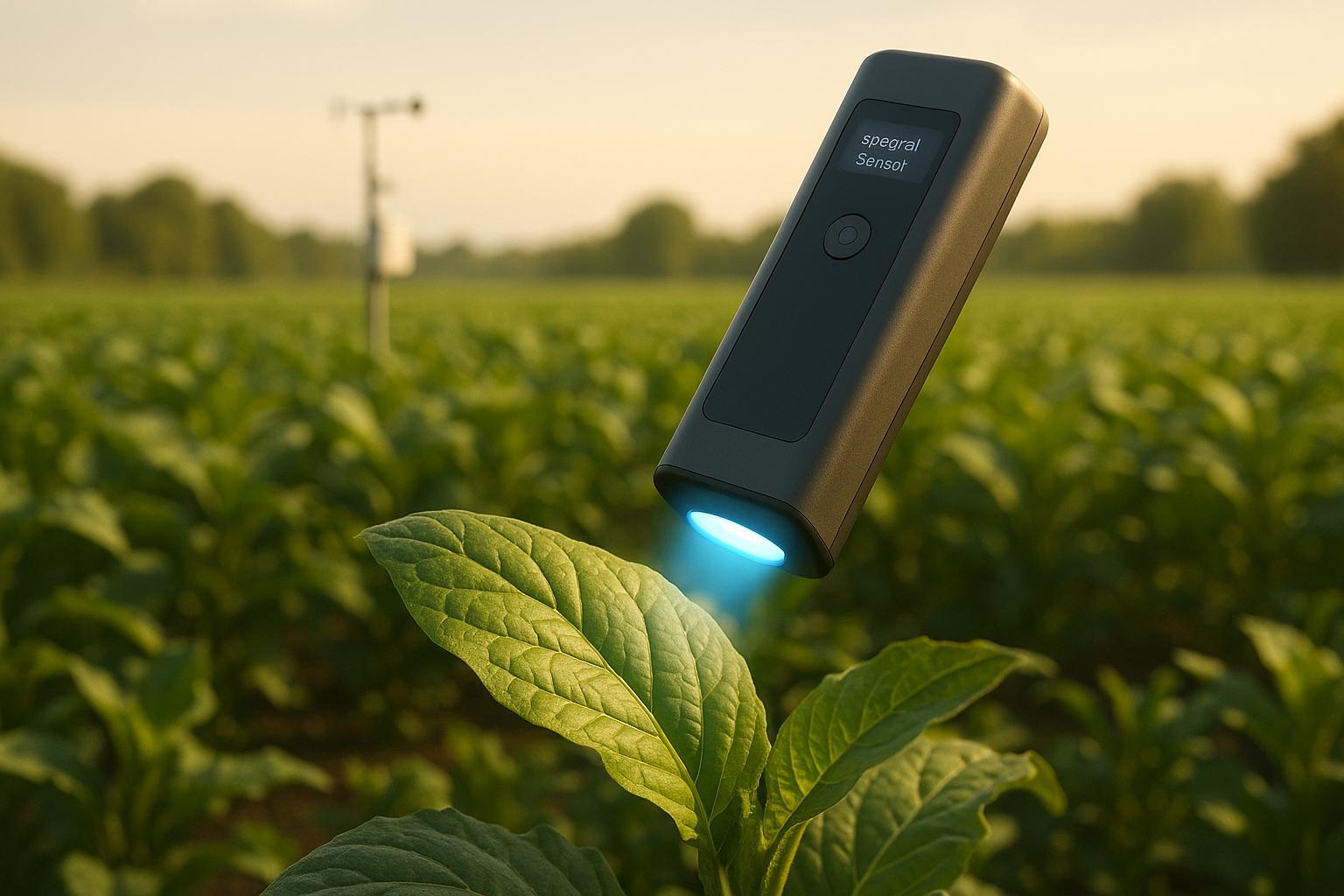
Data Fusion for Plant Disease Detection
Explore how data fusion combines spectral and environmental data to enhance plant disease detection, improving accuracy and early diagnosis.
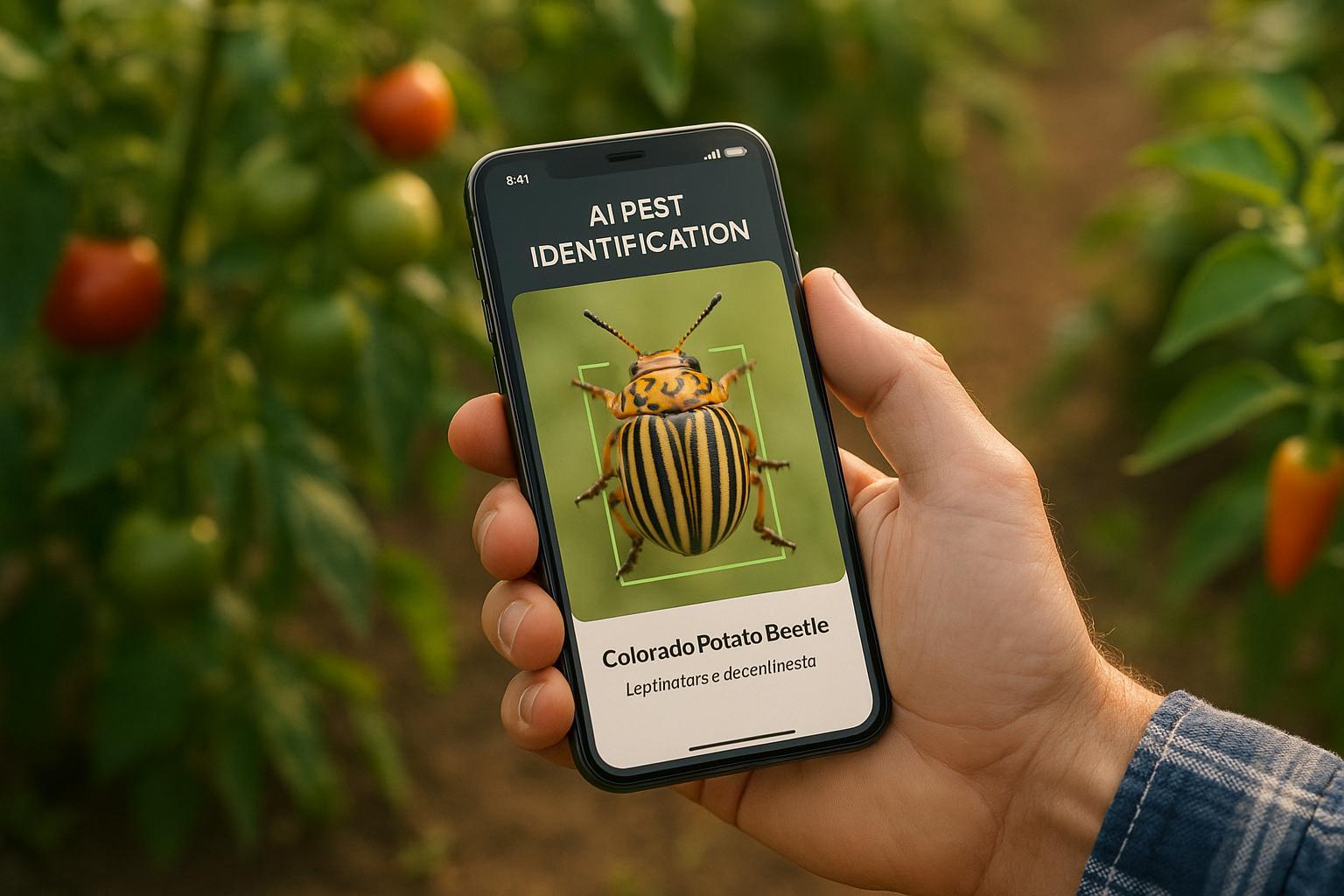
Ultimate Guide to AI Pest Identification Tools
Explore how AI pest identification tools revolutionize pest management for gardeners and farmers, offering efficiency, accuracy, and sustainability.

Impact of Droplet Size on Herbicide Efficacy
Understanding droplet size is crucial for optimizing herbicide effectiveness, balancing coverage, drift, and environmental impact.
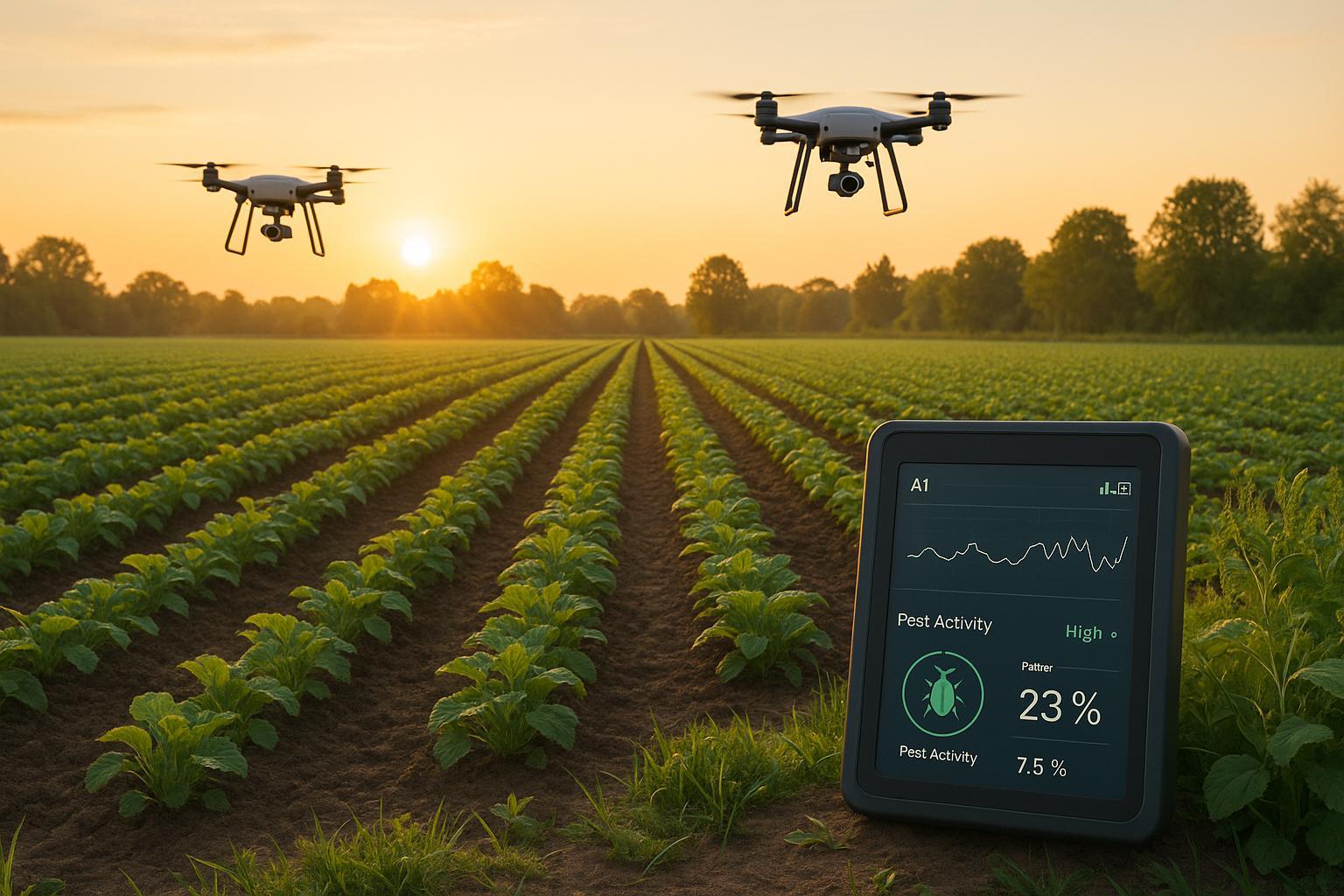
AI in Risk-Based Pest Control Systems
Explore how AI is revolutionizing pest control with predictive technologies that enhance efficiency and reduce pesticide use for farmers and gardeners.
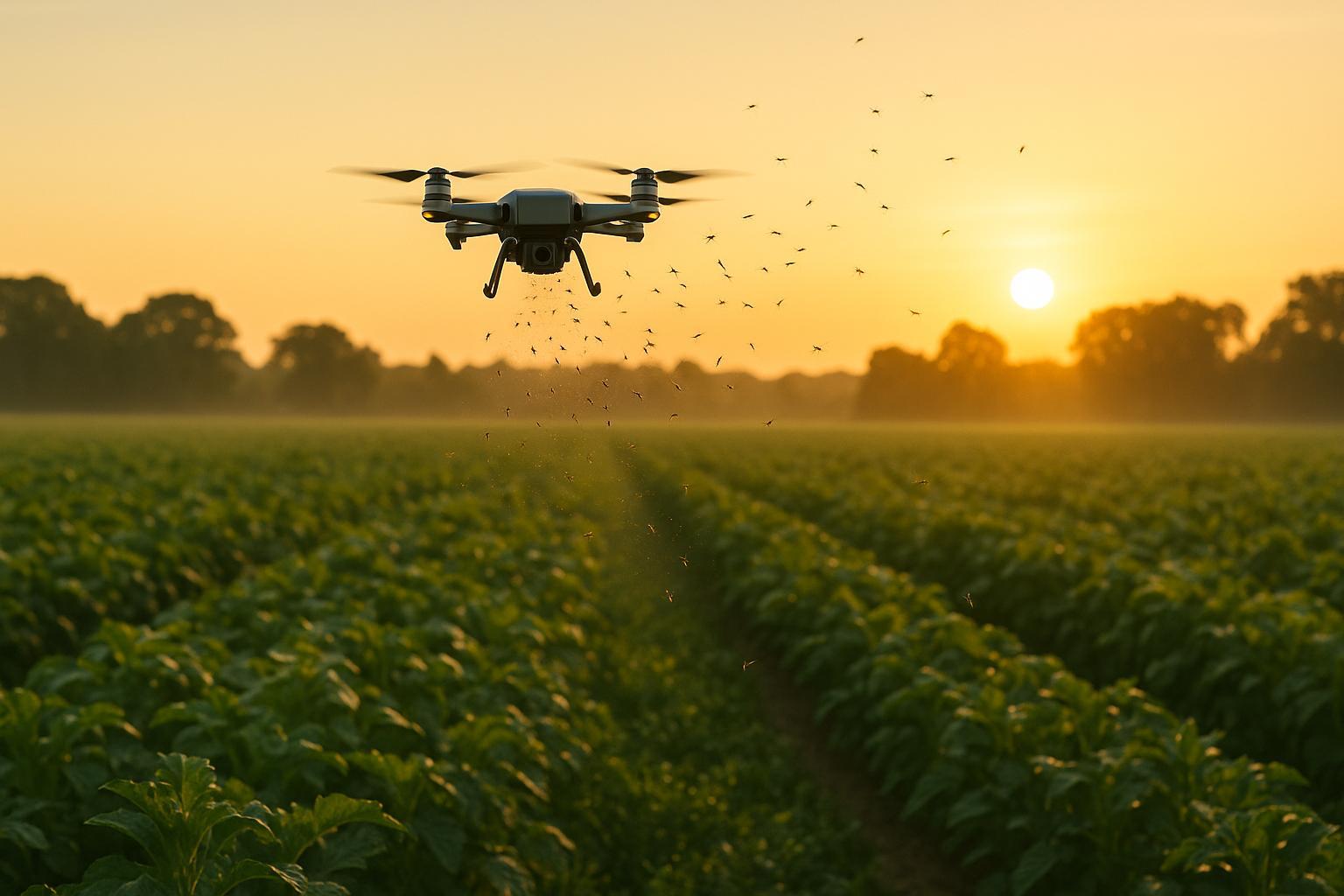
AI Timing for Parasitoid Releases
AI enhances the timing of parasitoid releases for pest control, improving effectiveness and reducing costs through data-driven insights.